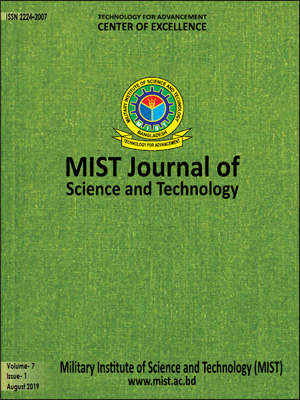APPLICATION OF SPACE SYNTAX ANALYSIS IN LALBAGH (Exploring the Links Between Spatial Analysis and Drug Crime Pattern in Selected Streets of Lalbagh, Dhaka)
Abstract
Drug crime is an urban problem, and in Lalbagh, its occurrence is fairly common. It can nevertheless be
prevented with surveillance, a feature of urban design. Spatial studies and criminology enable us to know
significantly about where and why crime occurs. Criminals are rational individuals and they weigh risks and
opportunities. A direct correlation can thus be found between the following variables: 1. Risk & Opportunity
and 2. Physical Implications of Urban Design which includes spatial attributes. The aim of this paper is to
identify the spatial attributes of a major drug crime location (Lalbagh) for helping urban planners, designers
and crime control authorities to identify crime zones easily for acting “proactively” rather than “reactively”
to the crime. While designing or examining neighbourhoods, for high values of Integration, Integration R=3
and Integration R=10 and Connectivity of an area, we can predict that area to be less crime-prone; because
with higher levels of movement, levels of co-presence and co-awareness are expected to be higher. Based
on this principle, selected streets of Lalbagh have been studied. Out of the other smaller streets of Lalbagh,
Road 10, Shahidnagar was found to be particularly prone to criminal activities and this paper is focused on
finding out the reasons behind it, on the basis of space syntax analysis. Depthmap software has been used as
a tool to analyze and explain this pattern of drug crime.
Downloads
References
Symposium, UCL, London, UK; 1997.
[2] Mamun, SB & Nilufar, F. Drug Crime and Urban Activity Pattern:
The Locational Choice of Drug Crime in Relation to Street Type and
Land Use. Proceedings of the 8th International Conference of Faculty
of Architecture Research Unit (FARU), University of Moratuwa, Sri
Lanka, pp. 000–000; 2015.
[3] Murray, C. “The Physical Environment,” Crime. San Francisco:
Institute of Contemporary Studies; 1995.
[4] Brantingham, PL & Brantingham PJ. Crime Pattern Theory,
“Environment Criminology and
Crime Analysis” Editor: Richard Wortley and Lorraine Mazerolle,
Cullompton,Uk: Willan; 2008.
[5] Brantingham, PL & Brantingham PJ. “Environment, Routine and
Situation: toward a pattern theory of crime”; 1993.
[6] Tabassum, T. Analyzing a Traditional Neighbourhood Pattern of
Old Dhaka: A Case of Tantibazaar; 2016.
[7] Nilufer, F. Hidden Morphological Order in an Organic City Journal
of Protibesh. 10. 33-40; 2004.
[8] Siddique, K et. al., Social Formation in Dhaka city - A study in
the third world urban society, Dhaka University press Iimited; 1991.
[9] Hillier, B & Hanson J. The Social Logic of Space”. Cambridge
University Press, Cambridge; 1984.
[10] Space Syntax, Available at: https://spacesyntax.com/about-us/,
Accessed on 2 February 2019.
MIJST follows the open access policy.

This work is licensed under a Creative Commons Attribution-NonCommercial 4.0 International License. This allows anyone to copy, share, distribute, and modify the work for non-commercial purposes, where the original work and source should be properly credited.
















